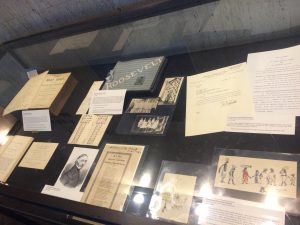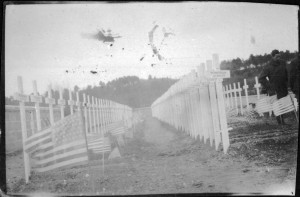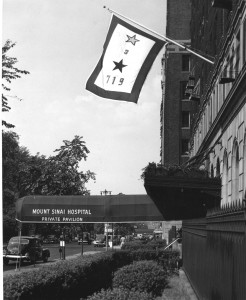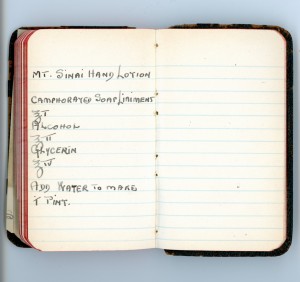Jul 21, 2016
The Mount Sinai Archives has received a large amount of new archival material over the last year, well over 186 feet of paper, photographs, and (sometimes) disintegrating leather-bound volumes. The bulk of these new collections contain material from Mount Sinai St. Luke’s Hospital and Mount Sinai West (the former Roosevelt Hospital), but they also include items documenting the Beth Israel Medical Center, Mount Sinai Queens, The Mount Sinai Hospital and the Medical School. Organizing, preserving and making available such a great quantity of material is a complex and time-consuming task, but the effort is well worth it, because these collections include many important historic treasures. Those treasures are the theme for a new Archives’ display in the Annenberg Building lobby. Here are some highlights from the display.
What makes a historical document or artifact a ‘treasure’? Sometimes, historical records provide information on an important person or an institution. The 1854 Bible belonging to the Rev. Dr. William Muhlenberg, founder of St. Luke’s Hospital, is an example of that, as are the newsletters and Annual Reports of the various Mount Sinai Health System hospitals that we have received. Other times, an item can be a ‘treasure’ because it provides context for what life was like at a specific period of time, highlighting how things have changed, or perhaps showing how some things never change. The Fathers’ Book from the Woman’s Hospital in the early 1940s does that, as do the reports created by the Mount Sinai Environmental Sciences Laboratory that are displayed. And sometimes what makes an item a ‘treasure’ is just that there is something appealing, unique or unexpected about it. Who would think that the Mount Sinai Archives has a World War II era U.S. War Department issued Japanese phrase book, currently on display in the Nursing case below the Stern Auditorium stairs? It is part of the papers sent to us by the daughter of Esther Winkler Shapiro, Class of 1944.
Perhaps the most surprising treasure we found as we put this exhibit together were the photographs and documents tucked into the back of a scrapbook from the Roosevelt Hospital School of Nursing, which was formed in 1896 and closed in 1974. This scrapbook, wrapped in the traditional blue stripe of the Roosevelt uniform, was created by Evelyn I.V. Howard, Class of 1908. The last few pages of the book include photographs and notes from Nina Gage, RN, a classmate of Miss Howard’s. These pieces document Gage’s years at a Red Cross hospital at the Hunan-Yale School for Nurses in Changsha, China from 1908-1915. There are photos of the facility as well as students and faculty members.

A view of one of the display cases showing Rev. Muhlenberg’s Bible in the far left corner and the Roosevelt nursing scrapbook in the middle.
If you are nearby, please stop in and take a look at our display. If you would like additional information, please contact us at msarchives@mssm.edu.
Jun 15, 2016
The Mount Sinai Archives has recently received the records that document the histories of the St. Luke’s Hospital, The Roosevelt Hospital, and the Woman’s Hospital in the State of New York, which merged with St. Luke’s in 1953. We are still in the process of ingesting these records and figuring out what we have, but one particular series has popped up that we couldn’t wait to highlight.
In the 1940’s, the Woman’s Hospital placed a small notebook in the waiting room on the maternity ward and asked prospective fathers to write their thoughts about their experience while there. The Archives has only four volumes, covering 1940-1944. It is unknown how long this practice continued. Still, the volumes that exist are wonderful to read, both for how the fathers (mostly) expressed their feelings as time passed and they waited with only occasional updates, as well as for how these volumes bear witness to the era in which they were created. There is a fervent entry about hoping this child will never have to know about Hitler or Nazis. There is another written by a grandmother because the father was a soldier. And there is the most obvious fact that marks them as from an earlier era: these fathers were all banished to a far away room and were not allowed to be part of the birth experience.
Below is just one page from the 1940/41 volume. It sums up the experience in the most simple of ways.

A page from the Fathers’ Book from the woman’s Hospital in 1940/41
May 24, 2016

The cemetery at Base Hospital No.3 for Americans who died at the hospital, 1918
Memorial Day is set aside to remember the servicemen and women who have died while in service to their country. Ceremonies started after the Civil War and it became a national holiday after World War II. Since injury and death are a part of war, doctors and nurses have always been witnesses to the ravages of battlefields. The image above shows the American cemetery at Base Hospital No. 3, the Mount Sinai Hospital-staffed unit that served in France.
While the deaths happened abroad, the biggest impact was felt at home. It was not only families that marked their losses, but institutions as well. By World War II, service flags were a familiar patriotic symbol. The photo below shows Mount Sinai’s flag hanging from 1184 Fifth Avenue. The number on the bottom shows how many Mount Sinai doctors, nurses, staff and trustees were in the service at that time. The gold star at the top showed how many had died. By the end of the war, Mount Sinai’s numbers had grown to 802 served, nine dead.

The Mount Sinai Hospital service flag, 1944
Those nine are recognized here:
- Nils Carson
- Sydney C. Feinberg, MD
- Andrew Goldstein
- Jerome W. Greenbaum, MD
- Eugene M. Holleb, MD
- Goodell G. Klevan, MD
- Bernard Ritter, MD
- Helen Rogers, RN
- Stanley J. Snitow, MD
May 13, 2016
As the Mount Sinai Archives continues processing and cataloging the records of the Beth Israel Medical Center (today’s Mount Sinai Beth Israel), we continue to discover interesting images and ephemera from Beth Israel’s history.

The photograph above shows Albert Einstein with Adolph Held (1885-1969), editor of the Jewish Daily Forward and brother of Dr. Isidor W. Held, a longtime member of the Beth Israel Hospital medical staff who served as President of the Medical Board from 1936 to 1938. (Update June 2017: When we first discovered this photograph in the collection, it had been incorrectly identified as a photograph of Dr. Held rather than his brother Adolph. Thanks to the family member who contacted the Archives with a correction.)
Dr. Held, a gastroenterologist, was involved in Jewish refugee aid in the aftermath of World War I, and during the rise of Nazism he became active in the movement to help medical and scientific emigres escape from Nazi Germany and its conquered territories, raising funds and publishing articles on behalf of persecuted Jewish physicians. These activities brought him into contact with Albert Einstein, who was himself a refugee from Nazi persecution and a vocal activist on behalf of other potential emigres.
This photograph is the only item in the Beth Israel collection that documents the relationship between Einstein and Dr. Held, but the Einstein Archives Online, a comprehensive directory of Einstein’s manuscripts, includes numerous entries for letters to and from Held and his wife Fanny. In 2006, a 1938 letter from Einstein to Held discussing the situation in Germany was sold at auction; the catalog listing includes a translation of the letter, which discusses their unsuccessful attempts to help an internist named Rudolph Ehrmann escape the “German gangsters.” (The following year, they were successful in obtaining passage to New York City for Dr. Ehrmann, who opened a private practice and became one of Einstein’s personal physicians.)
Dr. Held passed away in 1947. In addition to his legacy as an administrator, clinician and teacher of house staff, and the lives he saved as a refugee advocate, his posthumous impact at Beth Israel included an important annual lecture series endowed in his memory, which lasted until at least the late 1980s and brought numerous prominent physicians to BI’s downtown campus.
May 2, 2016
In honor of National Nurses Week, the Mount Sinai Archives would like to recognize that for over 100 years, Mount Sinai nurses have been doing it all, and then some. When she was a student at The Mount Sinai Training School for Nurses, Class of 1917, Sybil E. Elzas created a little notebook containing important things she needed to know on her clinical rotations, and then once out on her own as a graduate nurse. (Most professional nurses at this time still did private duty nursing, not hospital work.) The notebook was sized just right to slip into the pocket of her uniform’s apron. After pages and pages of definitions of terms and lists of operating room tray set-ups and dressings, towards the back of the book is a lone page noting the recipe for “Mount Sinai Hand Lotion.” Why purchase something nurses could so easily make, and at reduced cost?!
Nurses, still making a difference at Mount Sinai, 100 years later.

Inside cover of the clinic notebook belonging to Sybil E. Elzas. She is shown here as a student while on rotation to Sloane Hospital. The recipe for the lotion is at the end of the volume.








